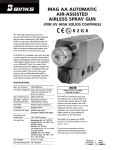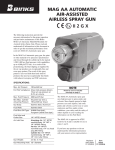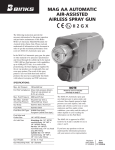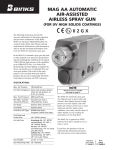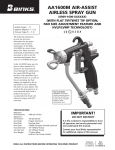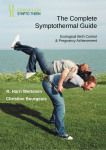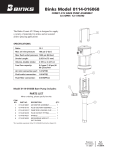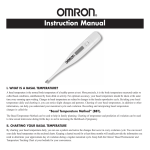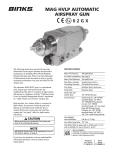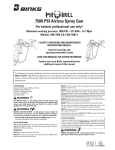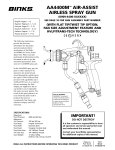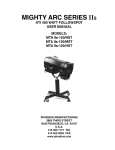Download Binks AA4000 Air Assisted Airless Spray Gun Operation and
Transcript
AA4000 AIR-ASSISTED AIRLESS SPRAY GUN II 2 G X The following instructions provide the necessary information for the proper operation and preventive maintenance of the Binks AA4000 Air-Assisted Airless Spray Gun. Please read and understand all information in this document in order to get the maximum performance from your new AA4000 spray gun. In the AA4000 spray gun, the paint or other material to be sprayed is preatomized and forced through the carbide tip by the typical 1,500-3,800 psi fluid pressure (with capabilities up to 4,000 psi/275 bar). As a result of the preatomizing, the final shaping air supplied by the air cap produces an exceptionally fine and even spray pattern. The result of this spray pattern is an even finish that lends itself to products that need an exceptionally fine finish with reduced overspray and VOC emissions. SPECIFICATIONS: Maximum Fluid Pressure: Maximum Air Pressure: Gun Body: Fluid Path: Fluid Shut Off Type: 4000 psi/275 bar 100 psi/6.8 bar Forged Aluminum Stainless Steel Tungsten Carbide Seat standard (UHMW Seat optional) Fluid Inlet Size: 1/4" NPS(m) Thread Air Inlet Size: 1/8" NPT(m) x 1/4" NPS(m) D.M. Nipple Gun Weight: 16-oz. Product shown is covered by U.S. patent No. 6,276,616. Foreign patents are issued or pending. Replaces Part Sheet 77-2776R-8 Part Sheet 77-2776R-9 ! WARNING HIGH PRESSURE CAN CAUSE SERIOUS INJURY IF EQUIPMENT IS INSTALLED OR USED INCORRECTLY— READ, UNDERSTAND, AND OBSERVE ALL WARNINGS AND INSTRUCTIONS IN THIS MANUAL. FLAMMABLE, EXPLOSIVE AND TOXIC VAPORS HIGH PRESSURE SPRAY AND HOSE LEAKS OPERATE EQUIPMENT ONLY AFTER ALL INSTRUCTIONS ARE CLEARLY UNDERSTOOD. In this part sheet, the words WARNING, CAUTION and NOTE are used to emphasize important safety information as follows: WARNING ! ! Hazards or unsafe practices which could result in severe personal injury, death or substantial property damage. CAUTION Hazards or unsafe practices which could result in minor personal injury, product or property damage. INJECTION HAZARD Spray from the gun, hose leaks, or ruptured components can inject fluid into your body and cause extremely serious injury, including poisoning or the need for amputation. Splashing fluid in eyes or on skin can also cause a serious injury. • Fluid injected into the skin might look like just a cut, but is a serious injury and should be treated as such. GET IMMEDIATE MEDICAL ATTENTION. INFORM THE PHYSICIAN WHAT TYPE OF MATERIAL WAS INJECTED. • Do not point the spray gun at anyone or any part of the body. • Do not put fingers or hand over the spray tip. • Do not stop or detect fluid leaks with a rag, hand, body or glove. • Do not use a rag to blow back fluid. THIS IS NOT AN AIR SPRAY GUN. • Engage the gun safety when not spraying. • ALWAYS RELIEVE THE PRESSURE WHENEVER WORKING ON THE SPRAY GUN. • Tighten all fluid connections before operating equipment. • Check all hoses, tubes, and couplings daily. Replace all worn, damaged, or loose parts immediately. Hazardous fluids or toxic fumes can cause serious injury or death if splashed on skin or in the eyes, swallowed or inhaled. TOXIC FLUID HAZARD • Know the specific hazards of the fluid you are using. This information is on the MSDS for the material being used. Read all fluid manufacturer’s warnings. • Store hazardous fluids in approved containers only. Dispose of all hazardous fluids in accordance with all state, local and national guidelines. • Wear the appropriate protective clothing, gloves, eyewear and respirator. Equipment misuse can cause the equipment to fail, malfunction, or start unexpectedly and result in serious injury. NOTE Important installation, operation or maintenance information. • Use the equipment only for its intended purpose. If you are unsure about its purpose call your local Binks distributor. • Do not alter or modify this equipment. Use only genuine Binks parts. • Do not exceed the maximum working pressure of the lowest rated system component. THE MAXIMUM RATING OF THE AA4000 IS 4000 PSI (275 BAR) FLUID PRESSURE. DO NOT EXCEED THE FLUID PRESSURE RATING. • Route all hoses away from all sharp edges, moving parts, hot surfaces and high traffic areas. • Do not use hoses to pull the equipment. • Use only Binks approved hoses. Do not remove spring guards from hoses, these are on the hoses to prevent rupture from kinking at the connectors. • Use only solvents compatible with hoses and wetted parts of the equipment used. • Comply with all applicable local state and national fire, electrical, and other safety regulations. Improper grounding, poor air ventilation, open flames, or sparks can cause a hazardous condition and result in fire or explosion and cause serious injury. FIRE AND EXPLOSION HAZARD • Ground the equipment and object being sprayed. • Provide fresh air ventilation to avoid the build up of flammable fumes from the material being sprayed or from solvent. • Extinguish all open flames or pilot lights in spray area. • Electrically disconnect all equipment in the spray area. • Keep the spray area free from all debris, including solvent rags. • If there is any static sparking while using the equipment, STOP SPRAYING IMMEDIATELY. Identify and correct problem. NOISE LEVELS EQUIPMENT MISUSE HAZARD • This equipment is for professional use only. • Read and understand all instructional manuals, tags, and labels before operating equipment. • The A-weighted sound level of spray guns may exceed 85 dB(A) depending on the setup being used. It is recommended that ear protection is worn at all times when spraying. The Spray Gun models listed in the following declaration of conformity may be used in some potentially explosive atmospheres ONLY when the special conditions for safe installation and operation have been followed as expressed in this user manual (Part Sheet). These models are approved to ATEX regulations 94/9/EC, protection level: II 2 G X: Suitable for use in Zones 1 and 2. EC Declaration of Conformity Manuf. By: Industrial Finishing 195 Internationale Blvd. Glendale Heights, IL 60139 Type/Series: Manifold Mounted Automatic Spray Guns Model: AA1500, AA4000 The equipment to which this document relates is in conformance with the following standards or other normative references: EN ISO 12100-1&2:2003 and BS EN 1953:1999 and thereby conform to the protection requirements of Council Directive 98/37/EC relating to Machinery Safety Directive, and; EN 13463-1:2001, Council Directive 94/9/EC relating to Equipment and Protective Systems for use in Potentially Explosive Atmospheres, protection level II 2 G X. Approved By: ______________________________ Chuck McCulloch, 2 11/19/07 Date: ____________ Industrial Finishing Industrial Finishing reserves the right to modify equipment specification without prior notice. SPRAY GUN SET-UP 1. Connect your high-pressure airless fluid hose to the gun fluid inlet and tighten securely. 2. Connect your air hose to the gun air connection and tighten securely. 3. Set the fluid pressure at the gun’s lower end of the pressure range. A typical starting fluid pressure is 1600 psi. Actual starting pressure points may be higher or lower than 1600 psi and depend on the setup— including the type of pump used, the type of material sprayed, and the spray gun itself. 4. Using the control knob on the gun air regulator, set the air pressure at zero. 5. To test the spraying pattern, spray a piece of wood or cardboard with a fast pass about one foot away from the piece. The results of the test will allow you to determine the uniformity of the particle size and spraying pattern. 6. If the spraying pattern develops tails or is not uniform, gradually increase the air pressure as necessary to develop a uniform spraying pattern. Typically, 10 psi air pressure is adequate, since the air is used to shape the patterns rather than for atomization of the coating. 7. If the quality of spray is acceptable, begin spraying. If the spraying rate is too slow to keep up with the production line speed, or if the quantity of material sprayed is inadequate for acceptable coverage, gradually increase the fluid pressure in 50 psi increments using the fluid regulator control knob. However, note that as the fluid pressure increases, more air is needed to eliminate the tails. TYPICAL HOOK-UP Grounding Wire Regulator Pump Oil and Water Extractor Air In Air Regulator Air Gun Air Fluid Filter Fluid Figure 1 Fan pattern adjustment: turn knob counterclockwise to increase pattern; clockwise to decrease pattern (Fig. 2). Fan Control Knob Consistency in spraying can be increased across spray gun operators and similar spraying jobs by developing pressure standardization charts. Repeat step 6 until the required material coverage and spraying speed are achieved. If the maximum fluid pressure is reached before the required material coverage and spraying speed are achieved, you may need to switch to a larger fluid tip. Figure 2 FLUID TIP SELECTION Factors to consider in selecting a fluid tip for an airassisted airless spray gun include (1) the size of the parts being sprayed; (2) the production line speed; (3) the material flow rate and film thickness; (4) the viscosity of the material applied; (5) the type of material applied; and (6) the quality of atomization of the coating required. The selection of a fluid tip necessary to perform a specific spraying job is best determined through a combination of experimentation and expert advice from your material and equipment suppliers. FLUID HOSES Air-assisted airless spray guns operate at fluid pressures higher than operating pressures of air spray guns. As a result, when operating an air-assisted airless spray gun, it is critical to select the appropriate fluid hose that is rated for the pressure range at which the airless gun is operated. 3 TROUBLESHOOTING DEFECTIVE SPRAY PATTERNS The following procedure summarizes the steps that an operator must immediately take when the first signs of a defective spray pattern emerge. 1. Check the external portion of the fluid tip for material buildup. If buildup has occurred, secure the gun trigger safety switch and clean the gun fluid tip with a non-metal soft brush. 2. If the spray pattern exhibits signs of tails at the top or bottom ends of the pattern, increase the air pressure gradually until the tails disappear. 3. If increasing air pressure does not dissipate the tails, the fluid tip may be worn and may need to be replaced. Another sign of the need to replace a worn tip is a gradual decline in spraying pattern width. 4. If cleaning or replacing the fluid tip does not dissipate the tails; the spraying defect is most likely due to the material temperature and/or viscosity. 5. If pattern pulsation or blinking occurs, check the pressure regulators, all downstream regulators, and the pump. These may require further adjustment or even repairs. Distorted Pattern Tails Correct Pattern Hour Glass Figure 3 GENERAL TROUBLESHOOTING PROBLEM CAUSE ACTION Fluid leaking from the back of seal cartridge assembly (8) Worn seal or needle shaft. Replace needle packing cartridge (8). Fluid leaking from the front of the gun Needle ball worn or damaged. Replace needle packing cartridge (8). Worn seat assembly. Replace fluid seat (4). Spray tip seal leaking. Fluid in air passages Leaking around fluid seat. Tighten retaining ring (1) Replace carbide tip assembly (3). Tighten or replace fluid seat (4). Slow fluid shut off Fluid buildup on cartridge assembly. Clean or replace cartridge assembly (8). No fluid output when triggered Tip orifice plugged. Turn off fluid supply. Relieve pressure into a closed-grounded container. Engage trigger safety. Remove tip guard assembly (1) and air cap (2) and the carbide tip (3). Clean or replace carbide tip assembly (3). Turn off fluid supply. Relieve pressure into a closed-grounded container. Remove trigger (20). Remove needle packing cartridge (8). Loosen collet and move until the needle is flush with the rear of the collet. Tighten collet. Turn off fluid supply. Relieve pressure into a closed-grounded container. Turn off air supply to pump and relieve fluid pressure with bypass valve. Engage trigger safety. Very slowly loosen the hose connection at the gun to relieve any pressure in hose. Remove hose and clear obstruction. Collet on needle has slipped. Fluid filter or fluid hose plugged. IMPORTANT REGULATORY NOTE The AA-4000 Air-Assisted H.V.L.P. hand spray gun combines the proven efficiency of the Binks compliant spray guns with air-assisted atomization to yield a reliable, carefully engineered compliant spray gun. With 25' of 5/16" I.D. air hose and regulator set at only 20 p.s.i. the compliant air cap registers 10 p.s.i. of atomization air to shape and soften the spray pattern. The AA-4000 air-assisted H.V.L.P. gun operates at high transfer efficiencies and fully complies with all government regulations for H.V.L.P. spray guns. Max. Fluid Input: Max. static air pressure at regulator with 25' of hose to inlet: Max. Dynamic Gun Inlet Air Pressure: Gun Body: Fluid Path: 4 4000 p.s.i. 20 p.s.i. 15 p.s.i. Forged Aluminum Alloy Stainless Steel and Tungsten Carbide SPRAY PATTERN TROUBLESHOOTING PROBLEM CAUSE ACTION Fluttering Spray Pattern Insufficient fluid supply. Adjust fluid regulator or fill fluid supply tanks. Air in paint supply line. Check and tighten pump siphon hose connections, bleed air from paint line. Attempting to “feather” (Partially trigger gun). Cannot feather with an AA4000 gun. Striping Spray – Fingers Carbide tip partially plugged. Clean or replace carbide tip assembly. Irregular Pattern Fluid builds up on carbide tip, or tip partially plugged. Clean carbide tip. On defective side of pattern, air horn holes are plugged. Clean air horn holes with solvent and a soft brush. On defective side of pattern, air horn holes are plugged. Clean air horn holes with solvent and a soft brush or toothpick. Pattern pushed to one side, same side of air cap gets dirty AIR-ASSISTED AIRLESS SPRAY GUN MAINTENANCE AND CLEANING Maintenance of air-assisted airless spray guns includes (1) fluid tip wear and replacement; (2) lubrication; and (3) cleaning of the gun. FLUID TIP Operating an air-assisted airless spray gun with a worn fluid tip will result in increased usage of spraying material and therefore, HAP emissions. For example, an increase in the diameter of a tip from 0.015 inch to 0.021 inch due to wear can result in up to a 100 percent increase in material consumption and cost. To prevent waste in spraying material and non-value-adding costs, a maintenance schedule that includes fluid tip inspection and replacement must be established. LUBRICATION Proper lubrication is essential for optimum spray gun performance. Lubrication allows the equipment to operate easily and correctly. The spray gun should be lubricated after each cleaning. The points that need lubrication during the maintenance of air-assisted airless spray guns include (1) the fluid needle packing; (2) trigger pivot point. Gun lube is used to lubricate the fluid needle packing and trigger pivot point. ! CAUTION Never immerse the entire gun in solvent or thinners. Some gun parts will lose their lubricative film and wear more quickly. Additionally, solvents may carry impurities throughout the gun body and allow them to clog small air and fluid passages. CLEANING The following steps summarize the procedure for cleaning air-assisted airless spray guns: 1. Turn off the atomizing air supply to the gun. 2. Turn off air supply to the pump and relieve fluid pressure. This may be accomplished by opening the bypass/priming valve, if so equipped. 3. Place the siphon (suction) tube into a solvent container. If pump is directly immersed in material, remove the pump and immerse it in a solvent container. NOTE Use only compatible solvents that are identified as approved for cleaning and wash-off use. 4. Place the gun trigger safety switch in the locked position. 5. Remove the fluid tip and place it in a closed solvent container. 6. Adjust the pump air supply regulator to its lowest level (counter-clockwise). 7. Place the gun trigger safety switch in the unlocked position. 8. Turn on the air supply to the pump and close the bypass/priming valve, if so equipped. 9. Slowly adjust the pump air supply regulator until the pump begins to cycle. 10. Trigger the gun into a closed container until the fluid (continued) runs clear. ! WARNING Failure to reduce pump air supply pressure or to use a closed container can result in material “bounce-back”. Material “bounce back” can cause injury and damage. NOTE During cleaning, the gun may only be sprayed into a closed container, never flush the gun into the air or spray booth. 5 CLEANING (Continued) 11. Using a rag dampened with solvent, wipe the exterior surface of the gun. Additionally, some solvents are prohibited from being used for cleaning. The operator must take care to use only approved cleaning solvents for equipment cleaning. These materials are clearly labeled as approved for cleaning and wash off operations. If the operator has any question on selecting appropriate cleaning solvents, the operator should consult a supervisor or plant environmental staff. WIRE AND BALL ASSEMBLY AND SEAT REPLACEMENT Refer to assembly drawing on page 7 to locate numbered items. 1. Engage the trigger safety. 2. Shut off fluid pump and disconnect its air or power supply. 3. Release pressure from the entire fluid system, from the pump to the spray gun. 4. Remove tip guard assembly (1), air cap (2) and spray tip (3). Remove trigger (20) by removing the trigger stud (13) and the trigger screw (12). 5. Remove the AA4000 needle packing cartridge (8). 6. Carefully install new AA4000 needle packing cartridge (8). 7. Remove fluid seat (4) and o-ring. 8. Install new fluid seat (4) and o-ring. 9. Reinstall trigger (20), trigger stud (13) and trigger screw (12). 10. Reinstall air cap (2), spray tip (3) and tip guard assembly (1). AIR VALVE REPLACEMENT 1. Engage the trigger safety. 2. Shut off fluid pump and disconnect its air or power supply. 3. Release pressure from the entire fluid system, from the pump to the spray gun. 4. Remove trigger (20) by removing the trigger stud (13) and the trigger screw (12). 5. Remove air valve assembly (21). 6. Replace air valve assembly (21). 7. Reinstall trigger (20), trigger stud (13) and trigger screw (12). PARTS LIST When ordering, please specify Part No. (Not all part numbers are available for purchasing.) ITEM PART NO. NO. 1 54-4983 2 54-4978 ◆ 54-4980 3 113-0XXXX DESCRIPTION QTY. TIP GUARD ASSEMBLY .............. 1 AA4 AIR CAP (Standard) .............. 1 AA2 AIR CAP (Optional) ................ 1 CARBIDE TIP ASSEMBLY ............ 1 (See Tip Selection Chart, pg. 8) 4 4A 5 6 7 8 54-4960* 20-6037 ■ 54-4906 54-4986 54-4923* 54-4963* FLUID SEAT (Tungsten Carbide ........ Standard or UHMW Optional, 54-4926) 1 O-RING........................................ FLUID TUBE ASSEMBLY.............. GUN HEAD ................................ FRONT HEAD GASKET .............. NEEDLE PACKING CARTRIDGE.... 1 1 1 1 1 (4,000 PSI Maximum) 9 10 11 12 6 — 54-4925 54-4977 54-4939 GUN BODY (Not Sold Separately) FLUID INLET NUT........................ 1 FAN CONTROL ASSEMBLY ........ 1 TRIGGER SCREW ........................ 1 ITEM NO. PART NO. DESCRIPTION QTY. 13 14 15 16 17 54-4938 — 54-4947 54-4943 54-4975▲ TRIGGER STUD .......................... FLAT PLUG (Not Sold Separately) FLUID TUBE BRACKET SPACER .. FLUID TUBE BRACKET................ PUSH IN TUBE FITTING .............. 1 18 19 20 21 22 20-6718 54-4944● 54-4937 54-4909* 71-28 BUTTON HEAD CAP SCREW ...... FLUID INLET FITTING.................. TRIGGER...................................... AIR VALVE ASSEMBLY................ D.M. NIPPLE................................ 23 54-4725 FILTER ASSEMBLY (100 Mesh) ........ 1 1 1 1 1/8" NPT(m) x 3/8" O.D. 1 1 1 1 1 1/8" NPT(m) x 1/4" NPS(m) ◆ Also available: 20-6750-K10 (Kit of 10 O-rings for AA-4 Air Cap). * Available as part of Repair Kit 54-4993. ■ Also available: 20-6037-K10 (Kit of 10 O-rings). ▲ Alternate Push-In Tube Fitting (17) is included in gun package. ● Alternate Fluid Inlet Fitting (19)—order separately. AA4000 AIR-ASSISTED AIRLESS SPRAY GUN 13 12 11 10 14 9 8 21 15 20 1 16 22 7 6 4A 4 3 2 5 18 23 17 See note below (Alternate) 19 (Alternate) NOTE Do not overtighten for ease of filter replacement. Adequate torque required is 5 – 6 ft. lbs. 7 SPRAY TIP SELECTION CHARTS HOW TO ORDER THE AA 4000 AIRASSISTED AIRLESS SPRAY GUN PART NO. SIZE FAN WIDTH PART NO. SIZE FAN WIDTH 4000-0000-4 113-01110 113-01112 113-01114 .011 .011 .011 8"-10" 10"-12" 12"-14" 113-01806 113-01808 .018 .018 4"-6" 6"-8" 113-01304 113-01306 113-01308 113-01310 113-01312 113-01314 113-01316 .013 .013 .013 .013 .013 .013 .013 2"-4" 4"-6" 6"-8" 8"-10" 10"-12" 12"-14" 14"-16" 113-01906 113-01908 113-01910 113-01912 113-01914 113-01916 113-01918 .019 .019 .019 .019 .019 .019 .019 4"-6" 6"-8" 8"-10" 10"-12" 12"-14" 14"-16" 16"-18" 113-01506 113-01508 113-01510 113-01512 113-01514 113-01516 113-01518 .015 .015 .015 .015 .015 .015 .015 4"-6" 6"-8" 8"-10" 10"-12" 12"-14" 14"-16" 16"-18" 113-02110 113-02112 113-02114 113-02116 113-02118 .021 .021 .021 .021 .021 8"-10" 10"-12" 12"-14" 14"-16" 16"-18" 113-01706 113-01708 113-01710 113-01712 113-01714 113-01716 113-01718 .017 .017 .017 .017 .017 .017 .017 4"-6" 6"-8" 8"-10" 10"-12" 12"-14" 14"-16" 16"-18" 113-02410 113-02412 113-02414 113-02416 113-02418 .024 .024 .024 .024 .024 8"-10" 10"-12" 12"-14" 14"-16" 16"-18" 113-02710 113-02712 113-02714 113-02716 113-02718 .027 .027 .027 .027 .027 8"-10" 10"-12" 12"-14" 14"-16" 16"-18" (Standard AA4 Air Cap less Spray Tip) (Optional AA2 Air Cap order separately) Spray Tip must be ordered separately. Use this chart to determine orifice size and fan size required*. *Note: Listed Fan Widths based on 1000 PSI with water. Actual results may vary, depending on material viscosity. PART NO. SIZE FAN WIDTH 113-00702 113-00704 113-00706 113-00708 .007 .007 .007 .007 1"-2" 2"-4" 4"-6" 6"-8" 113-00902 113-00904 113-00906 113-00908 113-00910 113-00912 .009 .009 .009 .009 .009 .009 1"-2" 2"-4" 4"-6" 6"-8" 8"-10" 10"-12" 113-01104 113-01106 113-01108 .011 .011 .011 2"-4" 4"-6" 6"-8" FLUID SEAT APPLICATION CHART APPLICATION CHART APPLICATION CHART Carbide (Standard) .....54-4960 UHMW (Optional) ....54-4926 ACCESSORIES HOSES 71-4990 71-4991 71-8087 71-8088 AIR CAP APPLICATION CHART AA2 (Optional) 54-4980 Thin to Medium Materials AA4 (Standard) 54-4978 Medium to Hvy. Materials ACCESSORIES (Cont.) 15' Polyurethane Air Tubing ASM w/fittings, 3/8" O.D., 1/4" I.D. 25' Polyurethane Air Tubing ASM w/fittings, 3/8" O.D., 1/4" I.D. 15' 3/16" High Pressure Fluid Hose Assembly 25' 3/16" High Pressure Fluid Hose Assembly FITTINGS 54-4975 1/8" NPT Male x 3/8" O.D. Push-In Tube Fitting (optional) 54-4976 1/4" NPT Female x 3/8" O.D. Push-In Tube Fitting (optional) FLUID FILTERS 103-1241 100 Mesh Inline Filter, 4000 PSI working pressure 54-3655 100 Mesh (Element) Gun Mounted Filter, 5800 PSI w.p. 54-5010 100 Mesh (Screen) Gun Mounted Filter, 4000 PSI w.p. 54-4725 100 Mesh (Element) Gun Mounted Filter, 4000 PSI w.p. FLUID REGULATORS 845011 Less Gauge, 1000 to 3000 PSI regulated range 845013 Less Gauge, 2000 to 5000 PSI regulated range CLEANING KIT 54-4994 Cleaning Kit: Includes one standard stiff nylon pipe cleaning brush, full-size nylon brush, tip cleaner and Binks Gunners Mate lubricant. REPAIR KIT 54-4993 Replacement Parts Kit Items (Includes Items 4, 4A, 7, 8, 10 and 21) TEST GAUGES 54-4997 H.V.L.P. Test Gauge AA2 54-5022 H.V.L.P. Test Gauge AA4 REPLACEMENT FILTERS 54-1835 Replacement filters for 54-3655 and 54-4725 54-5012-K10 Replacement filter for 54-5010 Industrial Finishing Binks has authorized distributors throughout the world. For technical assistance or the distributor nearest you, see listing below. Binks Worldwide Sales and Service Listing: www.binks.com U.S./Canada Technical Service Office: 195 Internationale Blvd., Glendale Heights, IL 60139 Toll-Free Telephone: 1-888-992-4657 (U.S.A. and Canada only) Toll-Free Fax: 1-888-246-5732 WARRANTY This product is covered by Binks’ 1 Year Limited Warranty. 77-2776R-9 Revisions: (P2) Replaced warnings. 12/07 © 2007 Inc. All rights reserved. Printed in U.S.A.








